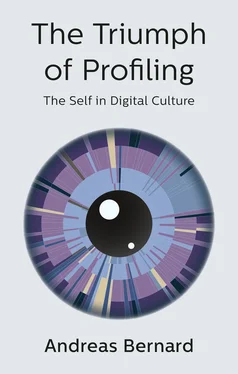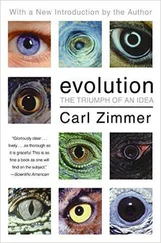Andreas Bernard - The Triumph of Profiling
Здесь есть возможность читать онлайн «Andreas Bernard - The Triumph of Profiling» — ознакомительный отрывок электронной книги совершенно бесплатно, а после прочтения отрывка купить полную версию. В некоторых случаях можно слушать аудио, скачать через торрент в формате fb2 и присутствует краткое содержание. Жанр: unrecognised, на английском языке. Описание произведения, (предисловие) а так же отзывы посетителей доступны на портале библиотеки ЛибКат.
- Название:The Triumph of Profiling
- Автор:
- Жанр:
- Год:неизвестен
- ISBN:нет данных
- Рейтинг книги:3 / 5. Голосов: 1
-
Избранное:Добавить в избранное
- Отзывы:
-
Ваша оценка:
- 60
- 1
- 2
- 3
- 4
- 5
The Triumph of Profiling: краткое содержание, описание и аннотация
Предлагаем к чтению аннотацию, описание, краткое содержание или предисловие (зависит от того, что написал сам автор книги «The Triumph of Profiling»). Если вы не нашли необходимую информацию о книге — напишите в комментариях, мы постараемся отыскать её.
In this book, Andreas Bernard examines contemporary profiling’s roots in late-nineteenth-century criminology, psychology, and psychiatry. Data collection techniques previously used exclusively by police or to identify groups of people are now applied to all individuals in society. GPS transmitters and measuring devices are now unconsciously embraced to have fun, communicate, make money, or even find a partner. Drawing perceptive parallels between modern technologies and their antecedents, Bernard shows how we have unwittingly internalized what were once instruments of external control and repression.
This illuminating genealogy of contemporary digital culture will be of interest to students and scholars in media and communication, and to anyone concerned about the power technologies hold over our lives.
The Triumph of Profiling — читать онлайн ознакомительный отрывок
Ниже представлен текст книги, разбитый по страницам. Система сохранения места последней прочитанной страницы, позволяет с удобством читать онлайн бесплатно книгу «The Triumph of Profiling», без необходимости каждый раз заново искать на чём Вы остановились. Поставьте закладку, и сможете в любой момент перейти на страницу, на которой закончили чтение.
Интервал:
Закладка:
This attitude was reflected in the spatial metaphors used to describe the internet at the time, including the concept of “cyberspace,” which Barlow had borrowed and redefined from William Gibson's novel Neuromancer . Cyberspace promised to be an egalitarian and immaterial space that was free from state and police intervention – “beyond government control,” as Fred Turner remarked in his book about the rise of digital utopias in California. 56 Barlow, who, like many of the movement's pioneering figures, came from the Californian counterculture, associated these fantasies about the unconstrained nature of virtual identities and spaces with LSD experiences during the 1960s and 1970s. He believed that the boundless online world would, like LSD, enable a psychedelic trip – one caused not by synthetic drugs but by information technology: “The computer itself was a new LSD.” 57 In Barlow's estimation, the important and utopian quality of this sphere lay in the fact that it could not be delineated and controlled, a characteristic that would give rise to a second spatial metaphor for the internet at the time: the electronic frontier. Just as nineteenth-century immigrants to the United States kept pushing westward, the early users of the internet were constantly entering unmapped territory where the inhabitants could express, according to Barlow's “Declaration,” their “authentic identity.” 58
Over the past 20 years, such fantasies about a fluid and multiple self in boundless space have obviously faded away. An entirely different concept – an entirely different genealogy of the internet and its collective subjects – has since taken their place. The profile, which began to appear on online-dating sites and in job-application culture around the same time as Rheingold's, Turkle's, or Barlow's eloquent theories, opposed these dreams of fluidity as a format that is oriented entirely around structure, predictability, and standardization. In the central methods of self-representation and self-perception that have since been established in digital culture, the subject and his or her space exist to be ascertained. To illustrate the gulf between these two concepts, all that is needed is to compare the passionate arguments from the 1990s in favor of the multiple self with the guidelines governing today's largest social network and its 2 billion active members. The section titled “Registration and Account Security” in Facebook's “Statement of Rights and Responsibilities” begins with the following injunction: “Facebook users provide their real name and information.” Other “responsibilities” that every member must accept when registering include: “You will not provide any false personal information on Facebook,” “You will not create more than one personal account,” and “You will keep your contact information accurate and up-to-date.” 59
Facebook's founder, Mark Zuckerberg, has himself stressed that the spectacular success of his business and its triumph over early competitors such as MySpace are in large part due to his insistence on the uniform and unambiguous identity of the site's users. In his interviews with the journalist David Kirkpatrick, which were published in 2010, he interpreted MySpace's indifference to the number and genuine nature of its users’ profiles as a decisive weakness and a target to attack: “MySpace was unconcerned with who you really were.” 60 His own flourishing network, in contrast, required from the beginning that each user could only have one profile and that it had to be under his or her real name. “You have one identity,” Zuckerberg repeatedly maintained in the interviews, and he spoke of the “lack of integrity” associated with the multiple and fictitious profiles created on MySpace. 61 According to his credo, “You can't be on Facebook without being your authentic self!” 62 Of course, the reasons for this insistence on authenticity were more commercial than philosophical, given that, from the outset, the business has been able to provide advertisers with a lucrative supply of real names and addresses. Regarding the conception of humanity in digital culture and the disappearance of the early discourse about the multiple subject, however, this mantra of the “authentic self” represents a threshold: the anonymous or disguised ego has given way to an ego that is readily identifiable. Just a few years after its announcement, Barlow's fluid category of “authentic identity” in cyberspace congealed into something that could not be better suited for police surveillance.
In his book From Counterculture to Cyberculture , Fred Turner framed the transitional process under discussion between two historical turning points: the campus protests at Berkeley in 1964, where students wore IBM punch cards around their necks to symbolize their powerlessness against the machinery of the university, and the publication of manifestos such as Negroponte's Being Digital and Barlow's “Declaration of the Independence of Cyberspace” in the mid-1990s. Turner's main objective was to explore how, within a period of 30 years, information technology was able to develop from a menacing and subject-inhibiting force into a sphere of social utopia and individual liberation. My considerations here about the status of the self in digital culture have described how this transformation has both progressed and regressed in recent years – developments that Turner, who completed his book before the advent of social media, could not have taken into account. For it ranks among the most irritating features of the current relation between subject formation and digital media technology that the promises of freedom declaimed during the pioneering years of the internet continue to provide the ideological basis of all new devices and services (every Apple presentation and every expansion of the sharing culture is an echo of the “virtual community”), while the methods of individualization – as shown by the development of the profile concept – are no longer intended to scatter subjects but rather to arrest them.
Notes
All references to online sources were last checked on September 3, 2018. 1Richard Bélanger et al., “U-Shaped Association Between Intensity of Internet Use and Adolescent Health,” Pediatrics 127 (2011), 330–5, at 334. For further discussion related to this debate, see the anonymous article “The Mystery of Aurora Suspect's Missing Facebook Account," cnet.com/news/the-mystery-of-aurora-suspects-missing-facebook-account; and Christoph David Piorkowski, “Spurlos im Netz: Wer sich Facebook verweigert, macht sich verdächtig,” Süddeutsche Zeitung (December 21, 2012), 13. 2Danah Boyd and Jeffrey Heer, “Profiles as Conversation: Networked Identity Performance on Friendster,” in Proceedings of the 39th Annual Hawaii International Conference on System Sciences (Los Alamitos: IEEE Computer Society, 2006), n.p. See also Danah Boyd, “Friendster and Publicly Articulated Social Networks,” in CHI 2004 – Connect: Conference Proceedings (New York: ACM Press, 2004), n.p.; and Danah Boyd and Judith Donath, “Public Displays of Connection,” BT Technology Journal 22 (2004), 71–82, at 72. These references to Boyd's essays – as well as references to other works relating to the history of the profile – were brought to my attention by Andreas Weich, whose dissertation on the history of the profile is due to be published shortly. For an overview of some of his findings, see Andreas Weich, “Sich profilieren und profiliert werden: Über zwei Seiten einer Medaille,” in Profile: Interdisziplinäre Beiträge, ed. Martin Degeling et al. (Lüneburg: Meson Press, 2017), 37–57. 3Boyd and Donath, “Public Displays of Connection,” 74. 4Boyd and Heer, “Profiles as Conversation,” n.p. 5Eric Partridge and Henry C. Wyld, eds., Webster Universal Dictionary: Unabridged International Edition (New York: Harver, 1968), s.v. ‘profile’ (p. 1163). 6Rossolimo's study was never translated into English. The quotation here is translated from the German edition: G. I. Rossolimo, Das psychologische Profil und andere experimentell-psychologische, individuale und kollektive Methoden zur Prüfung der Psychomechanik bei Erwachsenen und Kindern (Halle an der Saale: C. Marhold, 1926), 8. 7Karl Bartsch, Das psychologische Profil und seine Auswertung für Heilpädagogik: Ein Beitrag zur Erforschung der psychischen Funktionen des normalen und abnormalen Kindes, 2nd edn. (Halle an der Saale: C. Marhold, 1926), 3. 8The quotations are from ibid., 60, 73; and Fritz Giese, Psychotechnisches Praktikum (Halle an der Saale: Wendt & Klauwell, 1923), 40. 9Louis Gold, “The Psychiatric Profile of the Firesetter,” Journal of Forensic Sciences 7 (1962), 404–17. On the “mad bomber” and the role that psychoanalysis played in solving the case, see James Brussel, The Casebook of a Crime Psychiatrist (New York: Grove Press, 1968). 10Richard Ault and James Reese, “A Psychological Assessment of Crime: Profiling,” FBI Law Enforcement Bulletin 49 (1980), 22–5, at 22. 11Russel Vorpagel, “Painting Psychological Profiles: Charlatanism, Coincidence, Charisma, Chance, or a New Science?” The Police Chief 3 (1982), 156–9, at 156. 12Ault and Reese, “A Psychological Assessment of Crime,” 24. For a highly similar list, see Vorpagel, “Painting Psychological Profiles,” 159. 13Gold, “The Psychiatric Profile of the Firesetter,” 404, 416. 14Ault and Reese, “A Psychological Assessment of Crime,” 25. 15Anthony Rider, “The Firesetter: A Psychological Profile,” FBI Law Enforcement Bulletin 49 (July 1980), 7–17, at 7. 16On the number of cases in the United States, see Vorpagel, “Painting Psychological Profiles,” 159. Regarding the first criminal profile in Germany, see Cornelia Musolff, “Täterprofile und Fallanalyse: Eine Bestandaufnahme,” in Täterprofile bei Gewaltverbrechen: Mythos, Theorie und Praxis des Profilings, ed. Cornelia Musolff and Jens Hoffmann (Heidelberg: Springer, 2006), 1–23, at 12. 17On the history of registering psychiatric patients and on the development of documentary practices in various hospitals during the nineteenth century, see Ali-Reza Ipektschi, “Ärztliche Aufzeichnungen über Patienten im Allgemeinen Krankenhause in Hamburg in der Zeit von 1823–1888” (doctoral diss.: Universität Hamburg, 1983); Brigitte Bernet, “Der Fall des psychiatrischen Formulars,” in Zum Fall machen, zum Fall werden: Wissensproduktion und Patientenerfahrung in Medizin und Psychiatrie des 19. und 20. Jahrhunderts, ed. Sibylle Brändli et al. (Frankfurt am Main: Campus, 2009), 62–91; Volker Hess, “Formalisierte Beobachtung: Die Genese der modernen Krankenakte am Beispiel der Berliner und Pariser Medizin,” Medizinhistorisches Journal 45 (2010), 293–340; and Sophie Ledebur, “Schreiben und Beschreiben: Zur epistemischen Funktion von psychiatrischen Krankenakten, ihre Archivierung und deren Übersetzung in Fallgeschichten,” Berichte zur Wissenschaftsgeschichte 34 (2011), 102–24. 18J. C. Lavater, Von der Physiognomik (Leipzig: Weidmann, 1772), 63. This early work on physiognomy, which has not been translated into English, is distinct from Lavater's more comprehensive treatment of the subject, which appeared in multiple English editions under the title Essays on Physiognomy. 19Alphonse Bertillon, La photographie judiciare avec un appendice sur la classification et l'identification anthropométrique (Paris: Gauthier-Villars, 1890), 17. 20Here one could add yet a third level of meaning to the concept, which concerns the grooved or “profile” bicycle tires first patented by Dunlop or Palmer in 1880. In the Sherlock Holmes story “The Adventure of the Priory School,” it is the interpretation of these peculiar treads near the crime scene that sets the detective on the right track toward finding the missing pupil. At one point in the investigation, Holmes remarks: “I am familiar with forty-two different impressions left by tyres.” Quoted from Arthur Conan Doyle, “The Adventure of the Priory School,” in The Return of Sherlock Holmes (New York: A. Wessels, 1907), 119–58, at 136. 21For a screenshot of Match.com's homepage from 1995, see Mia de Graaf, “‘I Was Trying to Find the Right Person to Marry’: Match.com Co-Founder Reveals the Inspiration of Online Dating Site as It Goes Public,” Daily Mail (November 19, 2015): www.dailymail.co.uk/sciencetech/article-3324447/I-trying-right-person-marry-Match-com-founder-reveals-inspiration-online-dating-site-goes-public.html. The quotation of the 1996 advertisement was taken from a web page that is no longer active: kremen.com/wp-content/uploads/fi les/019_WEBSIGHT_0996_MATCH_AD.PDF. For a report about using the site, see Leslie Crawford, “Geek Love,” San Francisco Focus (October, 1996), 20: “You simply post your profile on-line and wait for the on-line love letters.” 22See Eva Illouz, Cold Intimacies: The Making of Emotional Capitalism (Cambridge: Polity, 2007), 74–114; and Illouz, Why Love Hurts: A Sociological Explanation (Cambridge: Polity, 2012), 198–237. 23See youtube.com/watch?v=MzE2cOqUFWM, at the 2:20 mark. 24Older online communities such as WELL (“Whole Earth 'Lectronic Link”), which was founded in California in 1985, did not make use of the profile format. Members dialed in with a user name and password and could comb through various thematically arranged sites and post comments. See Howard Rheingold, The Virtual Community: Homesteading on the Electronic Frontier, 2nd edn. (Cambridge, MA: MIT Press, 2000), 1–24; and Fred Turner, From Counterculture to Cyberculture: Steward Brand, the Whole Earth Network, and the Rise of Digital Utopianism (University of Chicago Press, 2008), 141–74. 25Andrew Weinreich, “Method and Apparatus for Constructing a Networking Database and System,” United States Patent No. US6175831 (1997). The patent can be read online at www.google.com/patents/US6175831. 26See Teresa Riordan, “Idea for Online Networking Brings Two Entrepreneurs Together,” New York Times (December 1, 2003): www.nytimes.com/2003/12/01/technology/technology-media-patents-idea-for-online-networking-brings-two-entrepreneurs.html. Reid Hoffmann, who is still the president of LinkedIn, has remained the owner of this patent ever since. 27Weinreich, “Method and Apparatus for Constructing a Networking Database and System,” n.p. 28The idea first appeared in a short story titled “Chain-Links” by the Hungarian author Frigyes Karinthy. 29These works have not been translated into English. Their original German titles are, respectively, Souverän im Vorstellungsgespräch, Erfolgreich im Assessment-Center, and Das große Bewerbungshandbuch. 30Christian Püttjer and Uwe Schnierda, Anschreiben und Lebensläufe für Hochschulabsolventen (Felde am Westensee: Sit-Up Verlag, 1999). 31Among others, the following books have appeared in various editions: Die Bewerbungsmappe mit Profil für Führungskräfte [“The Job-Application Portfolio with a Profile for Executives”], Die Bewerbungsmappe mit Profil für Hochschulabsolventen (mit Insiderkommentaren) [“The Job-Application Portfolio with a Profile for College Graduates (with Insider Commentary)”], Das große Bewerbungshandbuch (mit Püttjer & Schnierda-Profil-Methode) [“The Definitive Job-Application Handbook (with the Püttjer & Schnierda Profile Method)”], 20 perfekte Bewerbungen mit Profil [“Twenty Perfect Job Applications with a Profile”], Die Bewerbungsmappe mit Profil für Um- und Aufsteiger [“The Job-Application Portfolio with a Profile for Those Seeking to Transfer Jobs or Earn a Promotion”], Vorstellungsgespräch: Vorbereiten, überzeugen, gewinnen (mit Pütter & Schnierda-Profil-Methode) [“Interviews: Prepare, Persuade, Succeed (with the Püttjer & Schnierda Profile Method)”]. 32Püttjer provided me with this information in a telephone interview conducted on January 26, 2017. 33Christian Püttjer and Uwe Schnierda, Das große Bewerbungshandbuch, 2nd edn. (Frankfurt am Main: Campus, 2006), 25. 34Christian Püttjer and Uwe Schnierda, Das gelungene Online-Bewerbung (Frankfurt am Main: Campus, 2001), 85; Püttjer and Schnierda, Das große Bewerbungshandbuch, 20. 35Püttjer and Schnierda, Das große Bewerbungshandbuch, 25. 36See, for example, Püttjer and Schnierda, Anschreiben und Lebensläufe für Hochschulabsolventen, 79; and Püttjer and Schnierda, Das große Bewerbungshandbuch, 18, 220. 37The term “user profile,” for instance, can be found in demographic analyses as early as the 1970s. See Janpeter Kob et al., Profil der Benutzer öffentlicher Bibliotheken (Berlin: Deutscher Bibliotheksverband, 1973). 38See, for instance, John Burnett and Alan Bush, “Profiling the Yuppies,” Journal of Advertising Research 26 (1986), 27–35. 39Andreas Wenzlau et al., KundenProfiling: Die Methode zur Neukundenakquise (Erlangen: Publicis, 2003), 17–18 (emphasis original). 40See “Using Information from User Video Game Interactions to Target Advertisements,” United States Patent No. WO 2007041371 A3 (2007). Regarding the implications of this method, see Helmut Martin-Jung, “Verhaltensforschung,” Süddeutsche Zeitung (May 15, 2007), 1. The patent can be viewed online at https://www.google.com/patents/WO2007041371A3?cl=en. 41Petra Wittig, “Die datenschutzrechtliche Problematik der Anfertigung von Persönlichkeitsprofilen,” Recht der Datenverarbeitung 16 (2000), 61–9, at 62. In this passage, Wittig is in part citing the opinion of another lawyer. 42Christoph Schnabel, Datenschutz bei profilbasierten Location Based Services: Die datenschutzadäquate Gestaltung von Service-Plattformen für Mobilkommunikation (Kassel University Press, 2009), 172, 171. 43“Regulation (EU) 2016/679 of the European Parliament and of the Council of 27 April 2016 on the Protection of Natural Persons with Regard to the Processing of Personal Data and on the Free Movement of Such Data, and Repealing Directive 95/46/EC (General Data Protection Regulation)” (2016): http://eur-lex.europa.eu/legal-content/EN/TXT/?uri=CELEX:32016R0679, §71, §60, respectively. 44Ibid., §18. 45Schnabel, Datenschutz bei profilbasierten Location Based Services, 177. In terms of privacy law, one of the first studies to discuss the coexistence of unwittingly and actively created profiles is Louis Specht, Konsequenzen der Ökonomisierung informationeller Selbstbestimmung: Die zivilrechtliche Erfassung des Datenhandels (Cologne: Heymann, 2012). 46Michal Kosinski et al., “Our Twitter Profiles, Ourselves: Predicting Personality with Twitter,” in IEEE Third International Conference on Social Computing (Los Alamitos: IEEE Computer Society, 2011), 180–5. 47Michal Kosinski et al., “Private Traits and Attributes Are Predictable from Digital Records of Human Behavior,” Proceedings of the National Academy of Sciences 111 (2013), 5802–5, at 5802. See also the project's website at http://mypersonality.org/wiki/doku.php. 48Kosinski et al., “Private Traits and Attributes,” 5802. 49Kosinski et al., “Our Twitter Profiles,” 185 (emphasis original). 50Quoted from Alexander Nix, “The Power of Big Data and Psychographics in the Electoral Process,” a presentation delivered at the 2016 Concordia Summit. The presentation can be viewed on YouTube at https://www.youtube.com/watch?v=n8Dd5aVXLCc, and the citation here is taken from the 4:04 mark. For a discussion of Cambridge Analytica's methods, see Hannes Grassegger and Mikael Krogerus, “Ich habe nur gezeigt, dass es die Bombe gibt,” Das Magazin 48/3 (December 3, 2016): https://www.dasmagazin.ch/2016/12/03/ich-habe-nur-gezeigt-dass-es-die-bombe-gibt. 51Sherry Turkle, Life on the Screen: Identity in the Age of the Internet (New York: Simon & Schuster, 1995), 185. 52Ibid. 53Sherry Turkle, “Constructions and Reconstructions of Self in Virtual Reality: Playing in the MUDS,” Mind, Culture, and Activity 1 (1994), 158–67, at 164 (emphasis original). 54Rheingold, The Virtual Community, 149. 55John Perry Barlow, “A Declaration of the Independence of Cyberspace,” Electronic Frontier Foundation (February 8, 1996): https://www.eff.org/cyberspace-independence. 56Turner, From Counterculture to Cyberculture, 162. 57Ibid., 117. 58Barlow, “A Declaration of the Independence of Cyberspace,” n.p. 59Quoted from https://www.facebook.com/legal/terms. 60David Kirkpatrick, The Facebook Effect: The Inside Story of the Company that Is Connecting the World (New York: Simon & Schuster, 2010), 100. 61Ibid., 199. 62Ibid., 210.
Читать дальшеИнтервал:
Закладка:
Похожие книги на «The Triumph of Profiling»
Представляем Вашему вниманию похожие книги на «The Triumph of Profiling» списком для выбора. Мы отобрали схожую по названию и смыслу литературу в надежде предоставить читателям больше вариантов отыскать новые, интересные, ещё непрочитанные произведения.
Обсуждение, отзывы о книге «The Triumph of Profiling» и просто собственные мнения читателей. Оставьте ваши комментарии, напишите, что Вы думаете о произведении, его смысле или главных героях. Укажите что конкретно понравилось, а что нет, и почему Вы так считаете.












